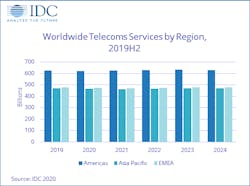Worldwide spending on telecommunications and pay TV services will reach nearly $1.6 trillion in 2020, a decrease of 0.8% compared to 2019, according to the International Data Corporation (IDC) Worldwide Semiannual Telecom Services Tracker.
IDC expects the decline to continue in 2021, but at a somewhat lower degree. The telecommunications services industry is proving to be one of the most resilient sectors of the global economy during the COVID-19 crisis, notes the analyst firm.
The anti-pandemic measures imposed by many governments that have forced people to stay at home and reduce face-to-face interactions have increased the consumption of telecom services. However, IDC warns that the economic impact from shutting down businesses, higher unemployment, frozen tourist activities, and reduced consumer spending on non-essential products and services will have a negative impact on the market.
The mobile segment, the largest segment of the market, is forecast to post a slight decline in 2020 due to lower revenues from roaming charges, less mobile data overages due to the stay-at-home situation, and slower net additions, especially in the consumer segment.
Fixed data services spending is projected to increase by 2.9% in 2020, as the need for more fixed Internet connectivity determined by the "great lockdown" is likely to help this segment maintain growth.
Meanwhile, IDC says spending on fixed voice services will continue to decline and will take an additional hit due to the pandemic as users will likely drop fixed voice services for savings purposes. Fixed IP voice is expected to survive longer, as the service is included in bundles in most cases.
IDC expects pay TV services will be boosted by the lockdown, but also affected by the economic downturn, so the spending in this category is expected to decline slightly.
Overall in 2020, the analyst says telecom services spending will drop in all geographic regions. The largest market, the Americas, will see a tiny decline of 0.04%. Europe, the Middle East, and Africa (EMEA) and Asia/Pacific (including Japan) will dip more, primarily because of the larger price-sensitive audience in the low-income countries of Africa and Asia.
Growth is not expected in EMEA or Asia/Pacific before 2022 as the users in emerging markets are expected to remain cautious about spending for some time.
Ultimately, IDC finds that the COVID-19 pandemic has changed some trends in the global telecom services market. Operators have quickly adapted to the forced changes in customer behavior and temporarily pushed aside some earlier priorities.
"As the 5G revolution is being put on hold or delayed by the pandemic, the already proven technologies and business cases will keep the ball rolling in these uncertain times," said Kresimir Alic, research director with IDC's Worldwide Telecom Services team. "Hosted VoIP/UCaaS, collaboration tools, SD-WAN, IoT, along with network optimization and increased reliability will keep consumers and businesses connected during the tough days of pandemic and global recession."
For more information about IDC's Worldwide Semiannual Telecom Services Tracker, please contact Kathy Nagamine at 650-350-6423 or [email protected].








